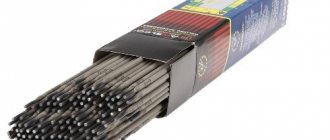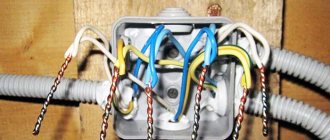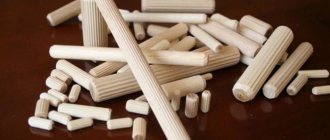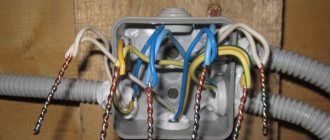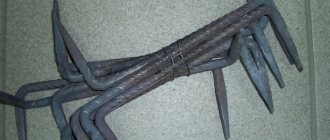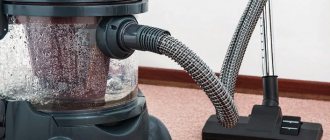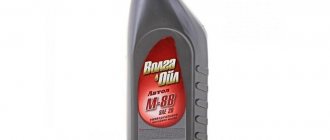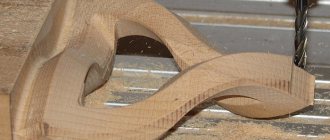In old houses and apartments, aluminum electrical wiring was made. This is due to the low price and availability of this metal. Nowadays copper conductors are often used, and there is a need to extend the core or install additional sockets, lighting fixtures, etc., but few people know how to connect aluminum and copper wire.
Consequences of contact between copper and aluminum
Let's consider the possible consequences using the example of a simple battery. Inside it there are 2 electrodes and an electrolyte. When metals interact, chemical processes occur and current is consumed or generated.
Some metals have oxidizing properties, while others have reducing properties. Their capabilities are indicated in the electrochemical voltage series. The degree of activity increases in one direction and decreases in the other. Here you can see compatible and incompatible contacts.
The farther apart metals are located in the electrochemical series, the greater the voltage between them will arise during a chemical reaction. The result of this will be the destruction of the metal located to the left.
If we compare nickel and cadmium, they are located nearby (through one element). The destruction of the latter occurs slowly; batteries or accumulators have a long service life.
Aluminum and copper have a big difference in the formation of stresses, so Al, located much to the left, will quickly collapse. A layer of oxides actively forms on its surface, which leads to deterioration of the contact and its overheating.
Rules for connecting copper and aluminum wires
Although it is not recommended to connect copper and aluminum cables, the need often arises. There are several ways to safely resolve the issue:
- By placing a third material between the conductors. To do this, it is better to use an inactive metal, such as brass, so that electrolysis does not start. Steel is highly conductive, so the joint will still heat up. This option is only suitable for networks with light loads.
- Reliable protection of the contact point from moisture. It is difficult to completely seal the connection, and it does not always work reliably. There are special pastes that prevent the entry of moisture and oxygen, so the wires do not oxidize and electrolysis does not begin.
Lubrication
To improve the quality of contact, you can use a special lubricant or paste. Usually this is quartz vaseline paste. It is usually used to improve the connection of aluminum wires.
But this paste can be used for all types of connections (threaded, using terminal blocks, crimping), especially if the connection takes place outdoors. Then the contact is affected by additional factors that significantly reduce the durability of the connection. Although the use of lubricant without insulation raises doubts.
What is the difficulty of connecting directly
The main problem when joining copper and aluminum is the development of electrocorrosion. If the environment is dry, then nothing happens when these metals combine directly. Moisture acts as an electrolyte, creating a “battery effect”. Metals, especially aluminum, are destroyed, and a break appears in the network, which leads to a short circuit or fire.
Electrochemical corrosion of joined metals
There is an opinion that it is unacceptable to connect aluminum and copper wires directly together and this is indeed a scientifically proven fact. Is it possible to connect a copper wire to a galvanized terminal? Of course, you cannot immediately give an answer, but in a minute you will be able to navigate this issue no worse than an experienced chemist.
What happens when two different current conductors come into contact? If there is no moisture, the connection will always be reliable. But there is always water vapor in the atmospheric air, which is the culprit for the destruction of contacts. Each current conductor has a certain electrochemical potential. This property of metals is widely used in technology, for example, thermocouples are made.
But if water gets between the metals, it forms a short-circuited galvanic cell, current begins to flow, and just as one of the electrodes is destroyed in the galvanic bath, so one of the metals in the connection is destroyed. The electrochemical potential of each conductive material is known, and knowing the value, you can accurately determine which materials can be connected to each other.
Table of electrochemical potentials (mV) arising between connected conductors
| Metal | Copper and its alloys | Lead-ol. solder | Aluminum | Duralumin | Steel | Stainless steel steel | Zinc coating | Chrome coating | Silver | Carbon (graphite) | Gold Platinum |
| Copper and its alloys | 0,00 | 0,25 | 0,65 | 0,35 | 0,45 | 0,10 | 0,85 | 0,20 | 0,25 | 0,35 | 0,40 |
| Lead-ol. solder | 0,25 | 0,00 | 0,40 | 0,10 | 0,20 | 0,15 | 0,60 | 0,05 | 0,50 | 0,60 | 0,65 |
| Aluminum | 0,65 | 0,40 | 0,00 | 0,30 | 0,20 | 0,55 | 0,20 | 0,45 | 0,90 | 1,00 | 1,05 |
| Duralumin | 0,35 | 0,10 | 0,30 | 0,00 | 0,10 | 0,25 | 0,50 | 0,15 | 0,60 | 0,70 | 0,75 |
| Soft steel | 0,45 | 0,20 | 0,20 | 0,10 | 0,00 | 0,35 | 0,40 | 0,25 | 0,70 | 0,80 | 0,85 |
| Stainless steel steel | 0,10 | 0,15 | 0,55 | 0,25 | 0,35 | 0,00 | 0,75 | 0,10 | 0,35 | 0,45 | 0,50 |
| Zinc coating | 0,85 | 0,60 | 0,20 | 0,50 | 0,40 | 0,75 | 0,00 | 0,65 | 1,10 | 1,20 | 1,25 |
| Chrome coating | 0,20 | 0,05 | 0,45 | 0,15 | 0,25 | 0,10 | 0,65 | 0,00 | 0,45 | 0,55 | 0,60 |
| Silver | 0,25 | 0,50 | 0,90 | 0,60 | 0,70 | 0,35 | 1,10 | 0,45 | 0,00 | 0,10 | 0,15 |
| Carbon (graphite) | 0,35 | 0,60 | 1,00 | 0,70 | 0,80 | 0,45 | 1,20 | 0,55 | 0,10 | 0,00 | 0,05 |
| Gold Platinum | 0,40 | 0,65 | 1,05 | 0,75 | 0,85 | 0,50 | 1,25 | 0,60 | 0,15 | 0,05 | 0,00 |
According to the requirements of the standard, mechanical connection between materials is allowed, the electrochemical potential (voltage) between them does not exceed 0.6 mV.
As can be seen from the table, the reliability of contact when connecting copper to stainless steel (potential 0.1 mV) will be much higher than with silver (0.25 mV) or gold (0.4 mV)!
And if a copper wire is coated with tin-lead solder, then you can safely connect it with aluminum in any mechanical way!
After all, then the electrochemical potential, as can be seen from the table, will be only 0.4 mV.
Connection methods
To overcome the described difficulties, the connection of copper and aluminum conductors is performed using:
- direct contact (twisting, rivets, soldering, crimping);
- indirect (bolt connection, terminal blocks).
The second group is preferable. If the first method is used, it is recommended to pre-tin the wires with solder.
With bolts and steel washers
This is an affordable way, the necessary elements are easy to find. You will need steel bolts, for example M4, M5, non-galvanized washers and nuts.
First, the insulation is removed from the ends of the wires and bent into rings. Place washers on the edges of the bolt and between the conductors and tighten the nut. The result is a sandwich-type connection that does not allow direct wire contact.
The disadvantage is that the design is bulky, and at high voltages it still heats up.
Using twist
This method is convenient because there are no additional elements, but it is rarely used to connect copper and aluminum.
If the use of twisting cannot be avoided, then adhere to the following rules:
- the ends of the wires are twisted; mutual wrapping of one around the other is not allowed;
- the copper core is coated with tin, especially if it is multi-conductor;
- The contact area is protected with a moisture-resistant compound (lithol, technical petroleum jelly, etc.).
There are 3 types of twist:
- simple;
- bandage - gives the best result;
- groove.
If the diameter of the connected wires is up to 1 mm, make at least 5 turns, and for wires of a larger cross-section - at least 3.
With terminals
The terminal block contact group (brass tube with screws) is located in a protective plastic case. You just need to insert the ends of the wires into the terminal and tighten the screws. Do not apply much force when tightening, so as not to break the aluminum core. There are no partitions inside the terminal, so when inserting the wires, you need to make sure that they do not touch each other. After some time, the screws may become loose and contact will deteriorate.
Using Wago terminal blocks
German Vago terminals are easy to use: just insert the wire into the hole where the plate will fix it. The advantage of this design is that here each core is located in a separate cell, so they do not touch each other. The manufacturer has already applied a paste to the terminals that prevents oxidation processes. The disadvantage is that they are disposable and cost a little more than other terminal blocks.
Screw terminal blocks
Screw terminal blocks allow you to connect two wires without direct contact between them. Two wires are inserted into the terminal block and pressed with screws. The disadvantage of this compression is the need to regularly tighten the screws, so they need to be mounted in places with easy access. They are also designed exclusively for lighting groups (although the manufacturer claims that they are also suitable for sockets), since they can withstand a low current load.
The main advantage of screw terminal blocks is their low cost. For example, the DKC 43112FV terminal block costs less than one hundred rubles.
Connection adapters
To connect wires with a cross-section of more than 4 mm², use a clamp called a “nut”. It has plates in its plastic body. Wires are clamped between them. Such a connection turns out to be bulky, and it cannot always be hidden in a box or behind a baseboard.
To connect single-core aluminum and bundled copper wires with a screw terminal, brass lugs are put on their ends. They prevent soft aluminum from being crushed when clamping the screw. They prevent the possibility of breakage of some of the wires in a stranded copper wire, which leads to a reduction in its cross-section. Using a tip eliminates such problems.
You can make an adapter yourself. To do this, solder 2 small pieces of copper and aluminum wires. After this, twist the copper end with the copper, and the aluminum with the aluminum, reliably isolate the contact points, then connect the electricity.
Video description
Soldering aluminum. Flux for soldering aluminum F-64.
Soldering with powder fluxes
The borax is intended for soldering using brass (copper) and silver solders Source expertsvarki.ru
Another opportunity to neutralize the oxide film (Al2O3) is the use of powder fluxes when soldering copper with aluminum. In such cases, a gas burner is most often used, and the powders are called powders. Perhaps someone imagines soldering as working with a soldering iron, but this is not entirely true, because for wires with a cross-section of 10 mm2 or more, a soldering iron is simply unsuitable, since it will not be able to heat them properly. Therefore, powder fluxes should not be discounted.
Here are some of the powders (powder fluxes):
- Sodium salt of boric acid, better known as borax (Na₂[B₄O₅(OH)₄]·8H₂O), is a white powder whose melting point is 700°C (the substance becomes viscous). This flux has a low cost, dissolves in water and is easily washed off with a solution of citric acid.
- Active flux F34-A. According to TU 48-4-229-87, it consists of 50% potassium chloride (KCl), 8% zinc chloride (ZnCl₂), 32% lithium chloride (LiCl) and 10% sodium fluoride (NaF). This substance is hygroscopic and dissolves well in water.
Why can't you connect directly?
Aluminum and copper cannot be connected directly for the following reasons:
- These metals have different coefficients of thermal expansion. As they heat up and cool down, the geometry gradually changes, as a result of which the connection weakens, overheats and a spark appears.
- An oxide film forms on the surface of aluminum, impairing contact. It also begins to overheat and break down.
- Two metals form a galvanic couple. This leads to their overheating and the results described above.
Tips and tricks
To create the most durable and reliable connection between a copper and aluminum core, experts advise adhering to the following rules:
- perform reliable insulation;
- connections are placed in junction boxes so that they can be tightened later;
- if you do not have the appropriate skills, then do not weld or solder the wires yourself;
- the bolted connection is periodically tightened;
- if twisting is performed, it is additionally protected with PPE caps;
- better soldering is obtained by replacing rosin with pure machine or gun oil;
- the size of self-clamping terminals depends on the choice of cross-section of the wires that they will connect;
- copper wire must be tinned;
- Paraffin, varnish or oil are not used as waterproofing.
There is no single way to connect these wires correctly. To get a good contact, take into account local conditions and the accessories available at hand, and then select one of the described options.
